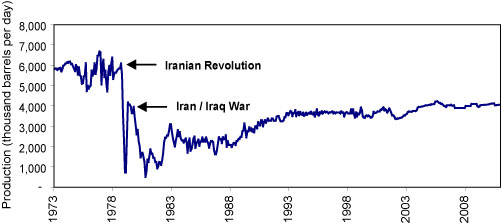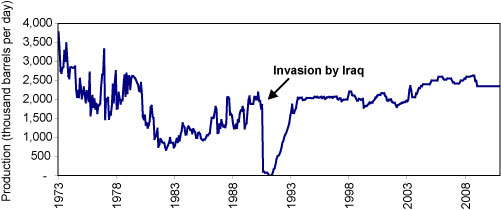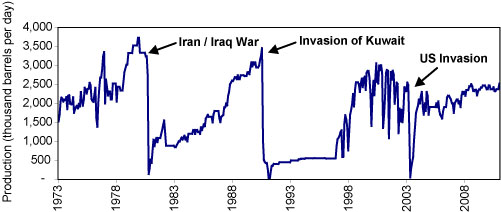Personal Wealth Management / Market Analysis
Libyan Oil Disruption Duration
Ongoing conflict in Libya has significantly impacted crude oil production from the country. While the lost production can be covered by spare capacity elsewhere in the region, the resulting tighter spare capacity can affect prices. So when is Libyan production likely to partially or fully recover? An analysis of historical war-related production disruptions—the Iranian Revolution, the Iran/Iraq War, the Gulf War, and the US Iraq invasion—may be useful in creating a framework for reasonable expectations. Here are some key observations:
- Oil production recovery is far more difficult without Western oil companies’ technological expertise.
- Sanctions and international opposition can prevent production recovery.
- In an ideal environment (i.e., internal stability, Western oil company participation, no sanctions), production can recover in about three years even following substantial infrastructure damage. Absent substantial infrastructure damage, a recovery could come much sooner.
The Iranian Revolution (1978-1979)
At the start of the Iranian Revolution in 1978, mass strikes, nationalization of oil infrastructure, and Western oil companies’ exodus drove Iran’s crude oil output from over 6 million barrels per day (b/d) to under 1 million b/d within months. However, oil infrastructure wasn’t severely damaged and production rebounded rapidly, reaching 70% of pre-revolution levels within a year.
Limited infrastructure damage makes an oil production recovery at least possible without significant support from Western oil companies.
The Iran/Iraq War (1980)
Saddam Hussein’s opportunistic 1980 invasion of Iran cut off Iran’s production recovery. Driven by infrastructure damage, Iranian production fell below 1 million b/d. The recovery was gradual, with output rising to 2 million b/d by 1983. After the war’s end in 1988, production increased from 2 million b/d to 3.5 million b/d by 1992—where it remains today.
Iraqi production also totally collapsed during the war. But unlike Iran, Iraq had access to Western oil companies and didn’t face international sanctions (then). Therefore, production began to rebound following the start of war, and recovered 50% in five years. Within a decade, Iraqi production reached new highs.
The disparity in Iranian and Iraqi recoveries illustrates the impact of Western oil companies’ technological expertise.
Iraqi Invasion of Kuwait (1990)
Both Iraqi and Kuwaiti oil production collapsed after Iraq’s August 1990 invasion. Iraq’s production fell from 3.5 million b/d to nil. By 1991, Iraqi production had rebounded somewhat—to 0.5 million b/d—where it stayed until 1996. The recovery was not only hampered by infrastructure destruction, but also sanctions and a lack of technical expertise. It wasn’t until 1996’s “Oil for Food” program that production markedly rebounded—reaching 3 million b/d by 2000.
Though Kuwait’s oil infrastructure suffered extensive damage during the conflict and production entirely collapsed, their recovery was far faster. Kuwait had little internal discord, didn’t face sanctions, and had access to Western oil companies’ expertise. Thus, production rebounded to pre-invasion levels of 2 million b/d by 1993.
Iraq’s rebound following the “Oil for Food” program highlights the impact of international sanctions, while Kuwait illustrates how rapidly production can rebound—even after significant damage—given the right conditions.
The US Invasion of Iraq (2003)
Iraqi production collapsed again following the US invasion in March 2003, falling from 2.5 million b/d to almost zero. However, within a year, nearly 80% of production had recovered, and full recovery occurred in 2007.
The US military presence and return of Western oil companies allowed fairly rapid production recovery—though infrastructure damage wasn’t severe in this case.
We believe it’s unreasonable to expect Libyan crude production to substantially recover until the conflict ends, Gadhafi is ousted, and a resulting new government gains international recognition. If and when those developments occur, the extent of infrastructure damage and the involvement of Western oil companies will play a critical role in determining the timing of Libya’s production recovery.
Iran Crude Oil Production
Source: US Department of Energy
Kuwait Crude Oil Production
Source: US Department of Energy
Iraq Crude Oil Production
Source: US Department of Energy
If you would like to contact the editors responsible for this article, please message MarketMinder directly.
*The content contained in this article represents only the opinions and viewpoints of the Fisher Investments editorial staff.
Get a weekly roundup of our market insights
Sign up for our weekly e-mail newsletter.

You Imagine Your Future. We Help You Get There.
Are you ready to start your journey to a better financial future?

Where Might the Market Go Next?
Confidently tackle the market’s ups and downs with independent research and analysis that tells you where we think stocks are headed—and why.








